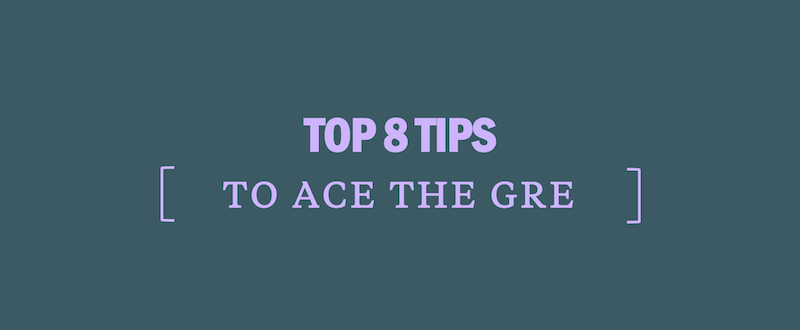Quantitative Comparison Strategies for the GRE
Quantitative Comparison problems are not like standard math problems you’ll find on the SAT or a common standardized test. Your job is not to find the correct answer amongst a group of answers (i.e. multiple choice) or to find the correct answer and write it in. You merely have to find out if one of the two expressions is larger, smaller, or equal to the other, or if such information is impossible to calculate. This may sound like a pain, but notice that you can get away with much less.
The art of quantitative comparison problems is getting away with the bare minimum to save time. Many quantitative comparisons are designed to look time consuming, which is a good indicator that there is a much faster way to solve the problem. Let’s look at some strategies that pinpoint those faster ways to solve quant comps: when to calculate, when not to calculate, and how to quickly compare variable expressions.
Avoid Unnecessary Calculation
If, in your practice, you notice yourself doing endless calculations, you are doing unnecessary work. The GRE will not make you do endless calculations on paper, even if such a strategy appears to be the most obvious way to reach an answer.
Before we examine certain question types, let’s look at a couple simple examples to show how immediate calculation can be an inefficient strategy:
1. 3569 OR 3(10) + 5 (10²) + 6 (10¹) + 9 (10^0)
If I saw this problem without thinking, I might multiply out the second column (3 times 10³ is 3000, etc). Such an approach is self-defeating. There is a simple trick here. Notice that 3569 is the same thing as saying 3000 + 500 + 60 + 9, which is what the expression on the right is really saying. Calculation is not necessary, and I know that both expressions are equal.
2. 31 x 32 x 33 x 34 x 35 OR 32 x 33 x 34 x 35 x 36
Again, if you don’t quickly examine the two expressions intelligently, you might jump into calculation, which would take you quite a while (not to mention leave you vulnerable to errors). Since we are just comparing the two expressions, we can cross out the numbers that appear in both expressions, that is, 32, 33, 34, and 35. Thus, we are left with a simple comparison: 31 OR 36; now it’s quite clear that B is greater.
Simplify
When presented with two baffling expressions, always think of ways to simplify before you calculate. Let’s check out this example:
1. 2,000,000 / 200, 000 OR 1,000 / 100
When you see many zeros in fractions like this, your first instinct should be to cross out matching zeros. If I have 2,000,000 in the numerator and 200,000 in the denominator, I should just eliminate five zeros from the top and 5 zeros from the bottom; now, my expression is simply 20/2 = 10. Same idea for column b: 1,000/100 = 10/1 = 10.
Simplify by Adding/Subtracting Same Value
1. 4x +5 OR 3x +6
I could approach this problem a few ways. First, I could use the tried and true plug-in method, where I would test a few simple numbers (preferably something like -2, 0, 2, and .5–you want to use a positive, a negative, 0, and a fraction). Don’t forget, though, that you can manipulate both expressions to make the comparison simpler. As long as I add or subtract the same number or variable from these expressions, I’ll have the same relationship between the two expressions. Remember, when choosing numbers to add or subtract, our goal is to make the relationship simpler, so:
Subtracting 5 from both sides gives us:
4x OR 3x+1
Subtracting 3x from both sides gives us:
x OR 1
Now, look how simple it is? The comparison is any number (x) OR 1, which is clearly indeterminate. Our answer is D.
Simplify by multiplying/dividing both sides by the same value
Let’s look at the problem we did above for the factoring method. We can actually use another method to figure out the answer. This just goes to show you that there is usually more than one way to solve a math problem. Though there is usually one “fastest” method, there are some rare cases when there are multiple quick methods to solving a problem.
1. 9^99 – 9^98 OR 9 ^98
Why don’t we divide both sides by 9^98?
1. 9^99 – 9^98 / 9^98 OR 9 ^98 / 9^98
9^1 – 9^0 OR 9^0
9-1 OR 1 → 8 OR 1→A
Warning
Do not simplify by multiplication or division unless you know the quantity you are using is positive.
Let’s look at an example where you would not want to use this method:
3x OR 4x
If we tried to simplify by dividing by x, we’d think that we arrived at this:
3 OR 4
We might choose B as a result, but we’d be wrong. When in doubt, use your common sense. It’s easy to see that, when comparing 3x and 4x, the answer must be D because when x= 0, the values are equal, or when we use a negative number, 3x is larger.
Factoring
Factoring is another popular way to simplify both expressions in order to make a comparison easier. Factoring doesn’t just mean pulling an x out of an expression. You can, and should, factor with constants (real, known numbers) in order to simplify. Let’s check out a few examples:
Example 1. 9^99 – 9^98 OR 9 ^98
Hmm. There’s no way I’m calculating this one. Let’s try to factor out a 9^98. It helps to remember your basic multiplication and exponent rules, e.g. (x^5)(x)= x^6
9^98 (9 – 1) OR 9^98
= 9^98 (8) OR 9^98
What’s bigger: a huge number times 8 or that huge number by itself? Clearly, A is bigger.
Example 2. 5x + 5y / x + y OR 5
Here’s a chance for some good ol’ fashioned factoring.
5( x +y ) / x +y OR 5
(X+Y) on top and bottom cancel, giving you: 5 OR 5
Easy choice. They’re equal.
Use 1, 0, a fraction, and a negative number as testers.
When you are testing variable expressions, the most reliable method to test them is to be thorough with the types of numbers you use. You must use a negative, a positive, a fraction, and a zero; we suggest that you use simple numbers in order to save yourself time and avoid any calculation errors.
Let’s check out some examples that show us why it’s necessary to be thorough.
Example 1: If x>0, y> 0, z= 0…
3z (2x +5y) OR 3x (2z+5y)
When a zero is on the outside, as in our A value, the whole value is zero. Since all the other values are positive, we can be confident that our second value is larger.
Example 2: If x<0, y >0, z=0
3z (2x +5y) OR 3x (2z+5y)
We still have zero for our first value, but we’re not in the clear quite yet. When negative numbers are involved, always test them. Testing our second value gives us 3(-1) (2*0 + 5*2). What we have is a negative multiplied by a positive, so we know the answer is negative. Our first value is larger.
Example 3: If 3x= 4y
x OR y
We know that if x and y are positive, then x is greater than y, e.g. if x is 4 then y is 3. But what if they are negative? If x is -4, then y is -3. So in that case, y is greater. And, what if x is zero? Well in that case, y is zero also, so both values are equal.
It turns out that the answer must be D.
Example 4: If x > 0 and x does NOT equal 1…
x ² OR x
So x must be positive and cannot be one. So in that case, it must be A right? Common Not so fast. Remember, our special numbers to test are negatives, positives, zeroes, and of course, fractions. Fractions have some very special properties. If we multiply a fraction by itself, it happens to become smaller, not bigger (.5 * .5 = .25).
So in that case, our answer is D.
There you have it. Try using different strategies to figure out which work best for you; remember, speed and accuracy are crucial!


